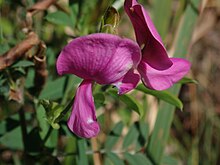| Tephrosia glomeruliflora | |
|---|---|

| |

| |
| Scientific classification | |
| Kingdom: | Plantae |
| Clade: | Tracheophytes |
| Clade: | Angiosperms |
| Clade: | Eudicots |
| Clade: | Rosids |
| Order: | Fabales |
| Family: | Fabaceae |
| Subfamily: | Faboideae |
| Genus: | Tephrosia |
| Species: | T. glomeruliflora |
| Binomial name | |
| Tephrosia glomeruliflora Meisn. | |
| Synonyms | |
Tephrosia glomeruliflora, or pink tephrosia, is a perennial (non-climbing) herb in the family Fabaceae, endemic to South Africa (native to Zimbabwe, South Africa and Eswatini). It is also found on the eastern coast of Australia, in New South Wales and Queensland, where it is considered an environmental weed.
Description
Tephrosia glomeruliflora is an erect shrub growing to 1–2 m high. Its branches are hairy with the hairs lying close to the branch. The pinnate leaves are 5–12 cm long; and there are 11-21 leaflets which are 15–40 mm long and 5–10 mm wide with an obtuse apex finishing in a tiny sharp point. The upper surface of the leaflets is sparsely hairy with the hairs pressed close to the leaflet, and the lower surface is silky-hairy. The petiole is 10–20 mm long. The stipules are ovate and 6–10 mm long. It flowers in terminal racemes, with clusters of buds enclosed on broad bracts. The calyx is silvery (from the hairs) and 4–5 mm long, with teeth which are 1–1.5 mm long. The corolla is 15–20 mm long and pink to mauve. The pod is 5–7 cm long and 7–9 mm wide, and smooth except for the hairy sutures.
Etymology
The genus name, Tephrosia, derives from the Greek tephros (ash-coloured) and refers to the fact that most of the species are covered with grey hairs. The species epithet, glomeruliflora, derives from the Latin, glomerulus, (clusters of flowers subtended by a bract), and flos (flower).
Habitat
In Africa, it grows in grasslands.
References
- Meisner, C.D.F. in Hooker, W.J. (1843), Contributions towards a Flora of South Africa. London Journal of Botany 2: 86
- "Tephrosia glomeruliflora". Australian Plant Name Index, IBIS database. Centre for Plant Biodiversity Research, Australian Government..
- ^ Govaerts, R. et al. (2018) Plants of the world online: Tephrosia glomeruliflora. Board of Trustees of the Royal Botanic Gardens, Kew. Retrieved 19 December 2018.
- ^ Harden, G. (1991) "Tephrosia glomeruliflora Meisn". PlantNET – FloraOnline. National Herbarium of NSW. Retrieved 19 December 2018.
- Weeds of Australia: Tephrosia glomeruliflora factsheet. Biosecurity Queensland edition. Retrieved 19 December 2018.
- Electronic Flora of South Australia genus Fact Sheet: Tephrosia Retrieved 19 December 2018.
- A grammatical dictionary of botanical Latin: glomerule. Missouri Botanical Garden. Retrieved 21 December 2018.
- Stearn, W.T. (1992) Botanical Latin (4th ed) p. 413. Timber Press, Portland, Oregon.
External links
- Occurrence data from GBIF for Tephrosia glomeruliflora
- Plants of the world online: Tephrosia glomeruliflora. (gives an overview)
- Shows specimens of Tephrosia glomeruliflora.
| Taxon identifiers | |
|---|---|
| Tephrosia glomeruliflora |
|